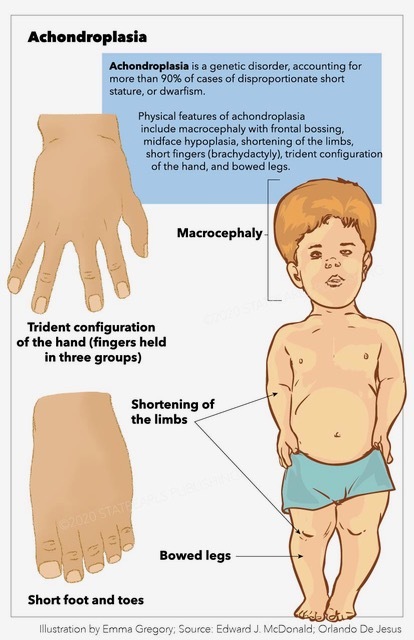Achondroplasia is a genetic disorder that affects bone growth, resulting in dwarfism. It is the most common form of dwarfism, caused by a mutation in a gene responsible for cartilage development. Individuals with achondroplasia typically have short arms and legs, a large head with a prominent forehead, and a flattened bridge of the nose. In addition to these physical characteristics, people with achondroplasia may also experience other health complications, such as spinal stenosis, which can lead to neurological issues. While there is no cure for achondroplasia, some individuals choose surgical interventions, such as limb lengthening, to address certain complications and improve height.
Nowadays, many people with achondroplasia are opting for achondroplasia limb lengthening surgery to increase their height. However, the decision to undergo surgery is personal and requires careful consideration of the risks, benefits, and individual health status. Limb lengthening surgery for achondroplasia is a complex and lengthy process, and not every individual with achondroplasia is a candidate for it.
What Is Achondroplasia Limb Lengthening?
Achondroplasia limb lengthening is a surgical procedure designed to lengthen the arms or legs of individuals with achondroplasia. By using advanced techniques such as distraction osteogenesis, the bones are gradually extended, which results in increased height. While this procedure can provide physical and psychological benefits, it is not a cure for achondroplasia and does not address all the health complications related to the condition.
Limb lengthening surgery achondroplasia is particularly sought after by individuals who desire increased height for better mobility, reach, or self-confidence. However, it is crucial to weigh the potential risks, such as nerve damage, infection, and joint instability, before undergoing this procedure.
Achondroplasia Limb Lengthening in Turkey
Turkey has gained recognition as a leading destination for limb lengthening for achondroplasia dwarfism due to its advanced medical facilities, expert surgeons, and competitive pricing. Many international patients travel to Turkey for limb lengthening surgery achondroplasia, as the country offers top-tier medical care at a fraction of the cost compared to the US or Europe.
In Turkey, achondroplasia limb lengthening surgery is performed by highly skilled orthopedic surgeons who use modern techniques like the LON Method and Precice 2 Method. These methods allow for precise control over bone lengthening, leading to better outcomes for patients. You can read more about the LON Method and Precice 2 Method to understand the available options.
Achondroplasia Limb Lengthening Surgery Cost in Turkey
One of the primary reasons patients choose Turkey for limb lengthening surgery is the affordability. The cost of achondroplasia limb lengthening surgery in Turkey is significantly lower than in many other countries, depending on the complexity of the procedure, the chosen method, and the surgeon’s expertise. This cost includes pre-operative evaluations, the surgery itself, and post-operative follow-up care, making it a comprehensive and cost-effective option for patients.
How Is Achondroplasia Height Extension Surgery Performed?
Achondroplasia height extension surgery is performed using either the LON Method or the Precice 2 Method. In both methods, the bones are surgically broken and gradually lengthened using a device.
- LON Method: This method involves the use of an external device to lengthen the bones after they are surgically cut. The external device applies tension to the bone, encouraging new bone growth in the gap created by the surgical break. More about the LON Method can be found here.
- Precice 2 Method: The Precice 2 Method uses an internal rod placed inside the bone, which is lengthened using a remote-controlled device. The advantage of this method is that it eliminates the need for an external device, providing greater comfort and ease of use. Learn more about this method here.
Both methods are highly effective for achondroplasia and limb lengthening, and the choice between them depends on patient preferences, health conditions, and surgeon recommendations.
What Are the Stages of Achondroplasia Height Extension Surgery?
The process of achondroplasia height extension surgery follows several stages:
- Pre-operative assessment: This involves detailed X-rays, physical evaluations, and discussions about the patient’s health history and goals.
- Surgical procedure: The surgeon cuts the bone and places the lengthening device (either internal or external).
- Distraction phase: The bone is slowly lengthened over weeks to months, allowing new bone tissue to form in the gap created.
- Consolidation phase: The new bone solidifies and strengthens over time. This phase can take several months and requires ongoing monitoring.
- Post-operative care: Physical therapy is essential for regaining muscle strength, flexibility, and proper limb function.
To Which Area Is Achondroplasia Height Enlargement Applied?
Achondroplasia limb lengthening typically focuses on the legs, specifically the femur (thigh bone) and tibia (shin bone). In some cases, arm lengthening may also be performed to improve overall limb proportions and functionality. The lengthening of the legs is generally prioritized, as it provides the most significant improvement in height and mobility for individuals with achondroplasia.
What Is the Procedure for Achondroplasia Limb Lengthening?
The procedure for achondroplasia limb lengthening involves breaking the targeted bone and then using a fixation device to slowly stretch the bone over time. This gradual extension allows the body to generate new bone tissue, leading to an increase in limb length. The procedure is carefully monitored, with frequent follow-ups to ensure the bone is healing properly and to prevent complications.
How Does the Doctor’s Follow-Up Continue After Achondroplasia Height Extension Surgery?
Post-surgery follow-up is critical to ensure the success of achondroplasia limb lengthening surgery. Doctors will monitor the patient’s bone growth, alignment, and healing through regular check-ups and imaging tests. Physical therapy is also a key component of recovery, helping patients regain muscle strength and mobility. Any potential complications, such as infections or nerve issues, are addressed promptly.
Who Is Achondroplasia Limb Lengthening Surgery Suitable For?
Achondroplasia limb lengthening surgery is suitable for individuals with achondroplasia who wish to increase their height and improve their limb proportions. Ideal candidates are in good overall health, have realistic expectations, and are committed to the lengthy recovery process. Both children and adults with achondroplasia can benefit from the surgery, although younger patients may experience faster healing.
How Limb Lengthening Surgery Can Impact People with Achondroplasia?
Limb lengthening surgery can greatly enhance the quality of life for people with achondroplasia. By increasing limb length, the procedure not only provides a taller stature but can also improve mobility, self-esteem, and independence. Many patients report an increase in confidence and a better ability to perform daily tasks.
The procedure can also offer practical benefits, such as easier access to higher objects and reduced risk of complications associated with achondroplasia, such as spinal stenosis. However, it is important to remember that limb lengthening does not cure achondroplasia. Continued medical care and management of other complications remain necessary even after surgery.
FAQ
Is Achondroplasia Height Increase Surgery the Definitive Solution to Increase Height?
Yes, achondroplasia limb lengthening surgery is a definitive solution to increase height for individuals with achondroplasia. It allows patients to gain significant height, often improving mobility and quality of life.
How Many Centimeters Does Achondroplasia Limb Lengthening Help to Grow?
Patients can gain between 10 to 15 centimeters in height through achondroplasia leg lengthening, depending on their specific condition and the surgical method used.
Will There Be Pain After Achondroplasia Lengthening Surgery?
Some pain and discomfort are common during and after the surgery, especially during the distraction phase. However, the pain can be managed with medication and generally subsides as the bones heal.
Is Achondroplasia Height Increase Surgery Safe?
Yes, when performed by a qualified and experienced surgeon, achondroplasia limb lengthening surgery is safe. However, as with any surgery, there are risks, including infection, nerve damage, and joint instability.
Is There an Age Limit for Achondroplasia Height Extension Surgery?
There is no strict age limit, but younger patients tend to heal faster and may achieve better results. Adults can still undergo limb lengthening surgery, but recovery may take longer.
In conclusion, achondroplasia limb lengthening offers individuals with achondroplasia a significant opportunity to improve their height, mobility, and overall quality of life. Through modern techniques like the LON Method and Precice 2 Method, patients can achieve remarkable results, especially when undergoing treatment in Turkey, a leading destination for limb lengthening surgery.



Op. Dr. Halil Buldu
Orthopedic Surgeon and specialist in Limb Lengthening & Deformity Correction with over 14 years of experiences
Author Page


